Texas sculptor David Adickes hopes his latest creation -- Dixie's newest tourist attraction -- isn't a big bust.
Presidents Park has been a headache for his creator and his backers as they fought legal and cultural battles for nearly a decade to reach last week's official opening of the US$10 million collection of mammoth statuary.
Heads have rolled -- across the country on flatbed trucks -- to populate this park with gigantic busts of all 43 presidents. How big are the concrete busts? Heights of around 6m, not counting the bases, and weights in the 3,401kg range. You could step on Abraham Lincoln's bow tie, grab an ear, climb on his beard, edge across his eyebrows and slide down his nose if you didn't mind a drop of more than 3m to the ground.
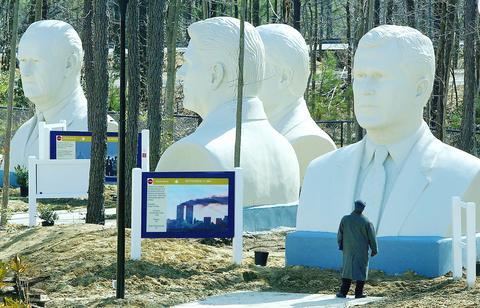
PHOTO: NY TIMES
Adickes -- whose works include the sculpture of former President George H.W. Bush at the Houston International Airport and the 23m-tall statue of Sam Houston in Huntsville, Texas -- says size is "in my DNA."
For his next major project, for instance, he aims to create the world's biggest statue. This "generic cowboy" will be the height of a 28-story building and be located in San Marcos, Texas, about midway between Austin and San Antonio. The 85m-tall cowboy would stand near Interstate-35, he said, and be seen by millions of motorists. Big art has more "impact," the 77-year-old sculptor explained.
Adickes got the idea for giant presidential busts after visiting Mount Rushmore and not being able to get as close as he wanted.
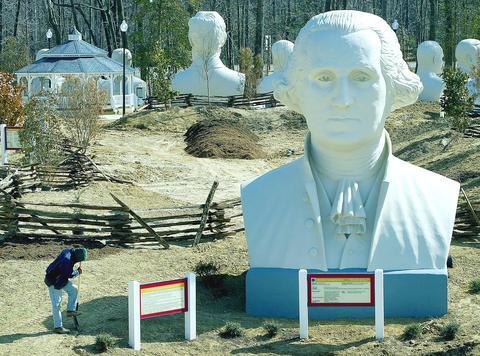
PHOTO: NY TIMES
"I was driving back to Texas from South Dakota," he said, when it hit him: "Wouldn't it be great to make statues of our presidents to be placed in a garden, at eye level, so we could really see them, study them, intimately and up close?"
He decided that this scenic, historic region would be a perfect setting. Millions of tourists already flock here to see Colonial Williamsburg, Jamestown and Yorktown -- carefully maintained landmarks in the story of early America. He found a wooded spot near some less historic attractions -- Water Country and Busch Gardens, amusement parks. He found a partner, local businessman Everette Newman III, who had developed Water Country and owned a Days Inn near the proposed site of Presidents Park.
However, when Adickes brought his idea and several sample presidential busts to Tidewater, Virginia about five years ago, some local folks tried to head off the project. They called it "tacky" among other things.
The proposed Presidents Park would be "like P.T. Barnum meets Easter Island," editorialized the Williamsburg Daily Press. "Veto the Presidents," the paper urged. Washington Post columnist Jonathan Yardley called it a "presidential Stonehenge."
Ivor Noel Hume, the retired residential archaeologist for Colonial Williamsburg, called the proposal "the tackiest project to exploit and pollute America's heritage" since Pocahontas "was turned into a musical."
County officials declared that the proposed Presidents Park would be an "outdoor commercial amusement," like a go-cart track or carnival rides or miniature golf course and needed a special use permit. Such a permit was unlikely to be granted. So Newman and Adickes went to court, arguing that Presidents Park would be an outdoor museum or sculptural garden.
On Sept. 8, 2000, Circuit Judge Prentis Smiley ruled that the park could in fact be built without a special use permit.
But by then, Adickes had decided to locate his first collection of giant presidential busts near Deadwood, South Dakota, and close to Mount Rushmore -- his inspiration. That park opened last year. Now he plans to locate a third presidential park near Tampa in Florida but the timetable is uncertain. He has made three presidential heads from each rubber mold -- working in a warehouse in Houston.
"Several years ago, I visited his studio in downtown Houston and was overwhelmed when I saw the busts he was doing of all 42 American presidents," former President Bush wrote in a 2000 letter endorsing the concept. "I agreed with him that the project was not only artistically important, but one of historical significance for our
country."
The elder Bush was the only president to pose for Adickes. He worked from photographs and paintings for the other sculptures. In his research, he noticed how presidential fashion evolved. Presidential ties, for instance, were ruffled lace for the first group of presidents -- George Washington up to Andrew Jackson, who is depicted in a military uniform with braid on his shoulders. Then bow-ties -- floppy at first -- were favored by presidents all the way up to Benjamin Harrison, who knotted the long ties worn by every president since. However, the rep stripe ties popular with presidents from Harry Truman on stopped with Bill Clinton.
The early presidents wore ribbons holding powdered wigs but were clean-shaven. Lincoln began the trend of presidential beards, which lasted until William Howard Taft and Theodore Roosevelt decided moustaches were more presidential. Woodrow Wilson was clean-shaven and no president since has sported facial hair.
In doing his research, Adickes said, he found that Jimmy Carter parted his hair on the left in some photographs and on the right in others. Jerry Ford was the hardest to do, said the sculptor, saying that his "square face" and regular features were difficult to distinguish. There are sites for eight more presidents. Should Bush be defeated in November, Adickes said, he will have his successor's bust done within six months.
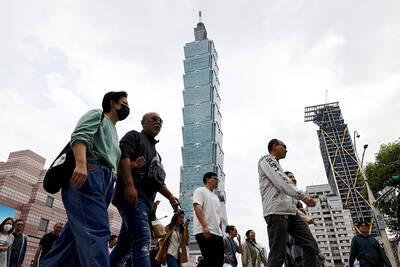
In the March 9 edition of the Taipei Times a piece by Ninon Godefroy ran with the headine “The quiet, gentle rhythm of Taiwan.” It started with the line “Taiwan is a small, humble place. There is no Eiffel Tower, no pyramids — no singular attraction that draws the world’s attention.” I laughed out loud at that. This was out of no disrespect for the author or the piece, which made some interesting analogies and good points about how both Din Tai Fung’s and Taiwan Semiconductor Manufacturing Co’s (TSMC, 台積電) meticulous attention to detail and quality are not quite up to

April 21 to April 27 Hsieh Er’s (謝娥) political fortunes were rising fast after she got out of jail and joined the Chinese Nationalist Party (KMT) in December 1945. Not only did she hold key positions in various committees, she was elected the only woman on the Taipei City Council and headed to Nanjing in 1946 as the sole Taiwanese female representative to the National Constituent Assembly. With the support of first lady Soong May-ling (宋美齡), she started the Taipei Women’s Association and Taiwan Provincial Women’s Association, where she
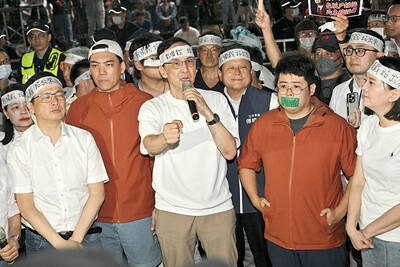
Chinese Nationalist Party (KMT) Chairman Eric Chu (朱立倫) hatched a bold plan to charge forward and seize the initiative when he held a protest in front of the Taipei City Prosecutors’ Office. Though risky, because illegal, its success would help tackle at least six problems facing both himself and the KMT. What he did not see coming was Taipei Mayor Chiang Wan-an (將萬安) tripping him up out of the gate. In spite of Chu being the most consequential and successful KMT chairman since the early 2010s — arguably saving the party from financial ruin and restoring its electoral viability —
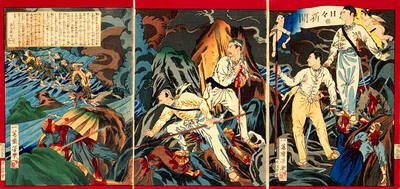
It is one of the more remarkable facts of Taiwan history that it was never occupied or claimed by any of the numerous kingdoms of southern China — Han or otherwise — that lay just across the water from it. None of their brilliant ministers ever discovered that Taiwan was a “core interest” of the state whose annexation was “inevitable.” As Paul Kua notes in an excellent monograph laying out how the Portuguese gave Taiwan the name “Formosa,” the first Europeans to express an interest in occupying Taiwan were the Spanish. Tonio Andrade in his seminal work, How Taiwan Became Chinese,